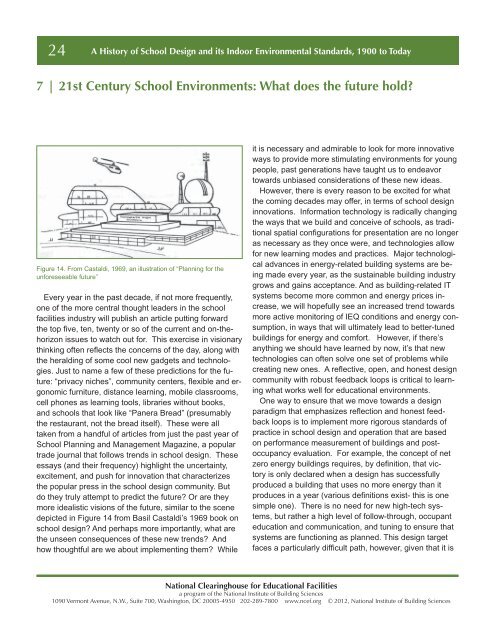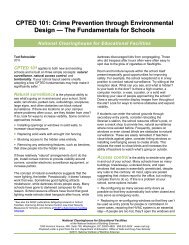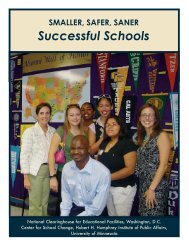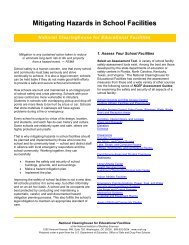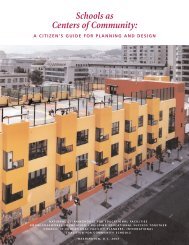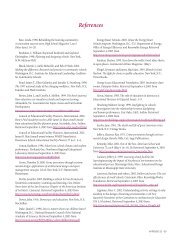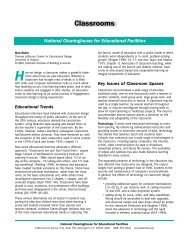A History of School Design and its Indoor - National Clearinghouse ...
A History of School Design and its Indoor - National Clearinghouse ...
A History of School Design and its Indoor - National Clearinghouse ...
You also want an ePaper? Increase the reach of your titles
YUMPU automatically turns print PDFs into web optimized ePapers that Google loves.
24 A <strong>History</strong> <strong>of</strong> <strong>School</strong> <strong>Design</strong> <strong>and</strong> <strong>its</strong> <strong>Indoor</strong> Environmental St<strong>and</strong>ards, 1900 to Today<br />
7 | 21st Century <strong>School</strong> Environments: What does the future hold?<br />
Figure 14. From Castaldi, 1969, an illustration <strong>of</strong> “Planning for the<br />
unforeseeable future”<br />
Every year in the past decade, if not more frequently,<br />
one <strong>of</strong> the more central thought leaders in the school<br />
facilities industry will publish an article putting forward<br />
the top fi ve, ten, twenty or so <strong>of</strong> the current <strong>and</strong> on-thehorizon<br />
issues to watch out for. This exercise in visionary<br />
thinking <strong>of</strong>ten refl ects the concerns <strong>of</strong> the day, along with<br />
the heralding <strong>of</strong> some cool new gadgets <strong>and</strong> technologies.<br />
Just to name a few <strong>of</strong> these predictions for the future:<br />
“privacy niches”, community centers, fl exible <strong>and</strong> ergonomic<br />
furniture, distance learning, mobile classrooms,<br />
cell phones as learning tools, libraries without books,<br />
<strong>and</strong> schools that look like “Panera Bread” (presumably<br />
the restaurant, not the bread <strong>its</strong>elf). These were all<br />
taken from a h<strong>and</strong>ful <strong>of</strong> articles from just the past year <strong>of</strong><br />
<strong>School</strong> Planning <strong>and</strong> Management Magazine, a popular<br />
trade journal that follows trends in school design. These<br />
essays (<strong>and</strong> their frequency) highlight the uncertainty,<br />
excitement, <strong>and</strong> push for innovation that characterizes<br />
the popular press in the school design community. But<br />
do they truly attempt to predict the future? Or are they<br />
more idealistic visions <strong>of</strong> the future, similar to the scene<br />
depicted in Figure 14 from Basil Castaldi’s 1969 book on<br />
school design? And perhaps more importantly, what are<br />
the unseen consequences <strong>of</strong> these new trends? And<br />
how thoughtful are we about implementing them? While<br />
it is necessary <strong>and</strong> admirable to look for more innovative<br />
ways to provide more stimulating environments for young<br />
people, past generations have taught us to endeavor<br />
towards unbiased considerations <strong>of</strong> these new ideas.<br />
However, there is every reason to be excited for what<br />
the coming decades may <strong>of</strong>fer, in terms <strong>of</strong> school design<br />
innovations. Information technology is radically changing<br />
the ways that we build <strong>and</strong> conceive <strong>of</strong> schools, as traditional<br />
spatial confi gurations for presentation are no longer<br />
as necessary as they once were, <strong>and</strong> technologies allow<br />
for new learning modes <strong>and</strong> practices. Major technological<br />
advances in energy-related building systems are being<br />
made every year, as the sustainable building industry<br />
grows <strong>and</strong> gains acceptance. And as building-related IT<br />
systems become more common <strong>and</strong> energy prices increase,<br />
we will hopefully see an increased trend towards<br />
more active monitoring <strong>of</strong> IEQ conditions <strong>and</strong> energy consumption,<br />
in ways that will ultimately lead to better-tuned<br />
buildings for energy <strong>and</strong> comfort. However, if there’s<br />
anything we should have learned by now, it’s that new<br />
technologies can <strong>of</strong>ten solve one set <strong>of</strong> problems while<br />
creating new ones. A refl ective, open, <strong>and</strong> honest design<br />
community with robust feedback loops is critical to learning<br />
what works well for educational environments.<br />
One way to ensure that we move towards a design<br />
paradigm that emphasizes refl ection <strong>and</strong> honest feedback<br />
loops is to implement more rigorous st<strong>and</strong>ards <strong>of</strong><br />
practice in school design <strong>and</strong> operation that are based<br />
on performance measurement <strong>of</strong> buildings <strong>and</strong> postoccupancy<br />
evaluation. For example, the concept <strong>of</strong> net<br />
zero energy buildings requires, by defi nition, that victory<br />
is only declared when a design has successfully<br />
produced a building that uses no more energy than it<br />
produces in a year (various defi nitions exist- this is one<br />
simple one). There is no need for new high-tech systems,<br />
but rather a high level <strong>of</strong> follow-through, occupant<br />
education <strong>and</strong> communication, <strong>and</strong> tuning to ensure that<br />
systems are functioning as planned. This design target<br />
faces a particularly diffi cult path, however, given that it is<br />
<strong>National</strong> <strong>Clearinghouse</strong> for Educational Facilities<br />
a program <strong>of</strong> the <strong>National</strong> Institute <strong>of</strong> Building Sciences<br />
1090 Vermont Avenue, N.W., Suite 700, Washington, DC 20005-4950 202-289-7800 www.ncef.org © 2012, <strong>National</strong> Institute <strong>of</strong> Building Sciences


